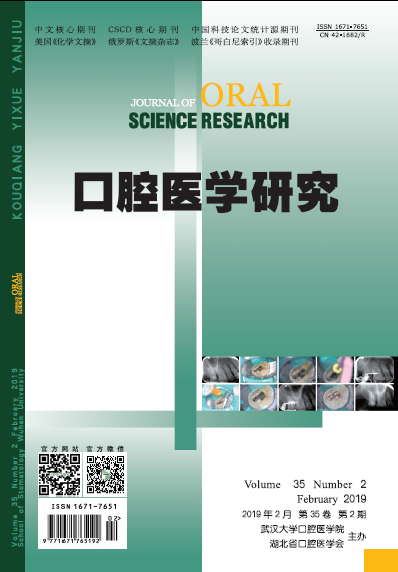|
|
Therapeutic Mechanism of Prunella Vulgaris Flavone Inhibiting Expression of Hypoxia-inducible Factor 1α in Rat Periodontitis.
LI Kun-yang, LI Wei, ZUO Chun-ran, CAO Li-sha, WANG Shou-ru, CHEN Dong
2019, 35(2):
151-154.
DOI: 10.13701/j.cnki.kqyxyj.2019.02.012
Objective : To investigate the expression of hypoxia-inducible factor-1α (HIF-1α) in the treatment of rat periodontitis. Methods: Forty male Wistar rats with specific pathogen free (SPF) were randomly divided into 5 groups (n=8) according to random number table, i.e. normal control group, model group, and prunella vulgaris flavonoid groups (50, 100, and 200 mg/L). P.gingivalis impregnated silk ligation was used to construct a periodontitis model. The treatment continued for 8 weeks, during which the model group and the control group were treated with the same amount of normal saline. Gross specimens of rat periodontitis were examined by light microscopy. The gingival index was measured by L e and Silness method, and the loss of periodontal attachment was detected by periodontal probe. The expression of HIF-1α in gingival tissues and serum was detected by enzyme-linked immunosorbent assay. The expression level of HIF-1α in chondrocytes was detected by immunohistochemical staining. Results: In the model group, periodontal inflammation was typical, and the gums were atro-phied. The periodontal attachment was severely lost. The furcation was exposed and more visible. After treatment with prunella vulgarisflavonoids, the gingival edema gradually reduced, the periodontal pockets gradually became shallower, and the gingival recession and periodontal attachment loss also improved. Compared with the normal control group, the gingival in-dex, degree of periodontal attachment loss and HIF-1α expression in the model group all increased (P<0.01). Compared with the model group, the gingival index, periodontal attachment loss and HIF-1α of the prunella vulgaris flavonoid group showed a gradual decline with the increasing of the concentration (P<0.05). Compared with only a few cells in the normal control group, HIF-1α was weakly positively expressed, and the HIF-1α(+) cells in the model group significantly increased. However, the HIF-1α(+) cells in the various doses of prunella vulgaris decreased, and the HIF-1α(+) cell rate significantly decreased in each dose group (P<0.01). Conclusion: Prunella vulgaris flavonoids can relieve periodontitis by reducing the expression of HIF-1α.
References |
Related Articles |
Metrics
|

